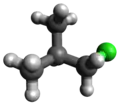| |||
| Names | |||
|---|---|---|---|
| Preferred IUPAC name
1-Chloro-2-methylpropane | |||
| Identifiers | |||
3D model (JSmol) |
|||
| 635650 | |||
| ChEMBL | |||
| ChemSpider | |||
| ECHA InfoCard | 100.007.417 | ||
| EC Number |
| ||
PubChem CID |
|||
| UNII | |||
| UN number | 1127 | ||
CompTox Dashboard (EPA) |
|||
| |||
| |||
| Properties | |||
| C4H9Cl | |||
| Molar mass | 92.57 g·mol−1 | ||
| Appearance | Colourless liquid | ||
| Density | 877 mg mL−1 | ||
| Melting point | −131 °C (−204 °F; 142 K) | ||
| Boiling point | 68.3 to 69.3 °C; 154.8 to 156.7 °F; 341.4 to 342.4 K | ||
| log P | 2.486 | ||
Henry's law constant (kH) |
630 nmol Pa−1 kg−1 | ||
Refractive index (nD) |
1.398 | ||
| Thermochemistry | |||
Heat capacity (C) |
158.6 J K−1 mol−1 | ||
Std enthalpy of combustion (ΔcH⦵298) |
−2.7012–−2.6844 MJ mol−1 | ||
| Hazards | |||
| GHS labelling: | |||
 | |||
| Danger | |||
| H225 | |||
| P210 | |||
| Flash point | −19.4 °C (−2.9 °F; 253.8 K) | ||
| Related compounds | |||
Related alkanes |
2-bromo-1-chloropropane | ||
Related compounds |
2-chloroethanol | ||
Except where otherwise noted, data are given for materials in their standard state (at 25 °C [77 °F], 100 kPa).
Infobox references | |||
Isobutyl chloride (1-chloro-2-methylpropane) is an organochlorine compound. It is a chlorinated derivative of isobutane.
Synthesis
Isobutyl chloride can be synthesized in a substitution reaction by reacting isobutanol with hydrochloric acid:
References
This article is issued from Wikipedia. The text is licensed under Creative Commons - Attribution - Sharealike. Additional terms may apply for the media files.

